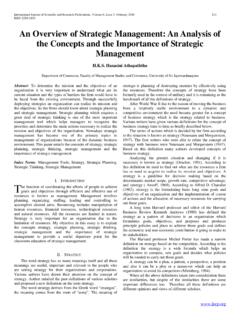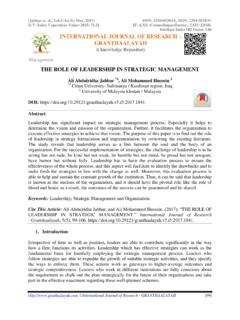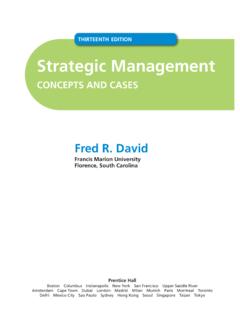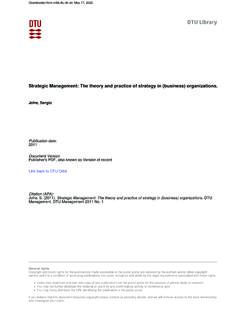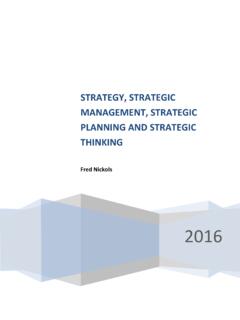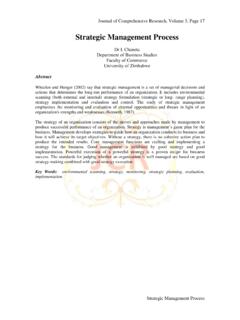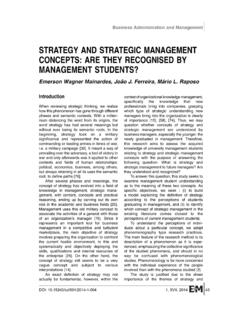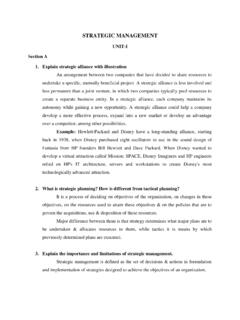Transcription of Strategic Marketing: Planning and Control, Third Edition
1 Strategic Marketing: Planning and ControlThis page intentionally left blank Strategic Marketing: Planning and ControlThird editionGraeme DrummondJohn EnsorRuth AshfordAMSTERDAM BOSTON HEIDELBERG LONDON NEWYORK OXFORDPARIS SANDIEGO SANFRANCISCO SINGAPORE SYDNEY TOKYOB utterworth-Heinemann is an imprint of ElsevierButterworth-Heinemann is an imprint of ElsevierLinacre House, Jordan Hill, Oxford OX2 8DP30 Corporate Drive, Suite 400, Burlington, MA 01803, USAF irst Edition 1999 Second Edition 2001 Copyright 1999, 2001, 2008 Published by Elsevier Ltd. All rights part of this publication may be reproduced, stored in a retrieval system or transmittedin any form or by any means electronic, mechanical, photocopying, recording or otherwisewithout the prior written permission of the publisherPermissions may be sought directly from Elsevier s Science & Technology RightsDepartment in Oxford, UK: phone ( 44) (0) 1865 843830; fax ( 44) (0) 1865 853333; e-mail: Alternatively you can submit your request online by visiting the Elsevier web site at , and selectingObtaining permission to use Elsevier materialNoticeNo responsibility is assumed by the publisher for any injury and/or damage to persons orproperty as a matter of products liability, negligence or otherwise, or from any use or oper-ation of any methods, products, instructions or ideas contained in the material Library Cataloguing-in-Publication DataA catalogue record for this book is available from the British LibraryLibrary of Congress Cataloging-in-Publication DataA catalog record for this book is available from the Library of CongressISBN: 978-07506-8271-8 Typeset by Charon Tec Ltd (A Macmillan Company), Chennai, and bound in SloveniaFor information on all Butterworth-Heinemann publicationsvisit our web site at Strategic perspective1 About this chapter3 Introduction3 What is strategy ?
2 4 Towards Strategic management6 Change shaping strategy8 Balanced scorecard approach9 The role of marketing within strategy10 What is marketing strategy ?12 Summary15 Part 1 Strategic Analysis172 External analysis19 About this chapter21 Introduction21 Scanning22 Macro-environmental analysis24 Industry analysis26 Competitor analysis29 Problems in identifying competitors33 The market analysis33 Summary343 Competitive intelligence37 About this chapter39 What is competitive intelligence?39 The CI cycle41 Sources of competitive information44 Summary454 Segmentation47 About this chapter49 Introduction49 Why segment?49 The segmentation process50 Consumer behaviour51 Consumer segmentation criteria57 ContentsProfile variables58 Behavioural variables66 Psychographic variables69 Organisational/industrial segmentation techniques73 Organisational buyer behaviour73 The Webster Wind framework76 The Sheth framework76 Approaches to organisational market segmentation81 Summary845 Internal analysis87 About this chapter89 Introduction89 Organisational capabilities90 Organisational assets90 Organisational competencies92 Initial corporate wide internal audit94 The internal marketing audit95 The innovation audit96 Auditing tools101 Summary1076 Developing a future orientation109 About this chapter111 Introduction111 Forecasting111 Trend extrapolation113 Modelling114 Intuitive forecasting114 Consensus forecasting115 Scenario planning119 Market sensing124 Strategic questions124 People involved125 Summary127 Part 2 Formulation of Strategy1297 Strategic intent131 About this chapter133 Introduction133
3 Mission133 Statement of Strategic intent138 Nature of support for the mission statement138 Goals and objectives140 Hierarchy of objectives142 Long-term versus short-term goals143 The balanced scorecard144 Gap analysis146 Summary146viContents8 strategy formulation149 About this chapter151 strategy formulation an overview151 Competitive advantage152 Identifying sources of competitive advantage156 Experience and value effects158 Industry position160 Product and market strategies166 Strategic wear-out172 Difficult market conditions172 Summary1749 Targeting, positioning and brand strategy177 About this chapter179 Introduction179 Evaluating market segments179 Establishing organisational capability183 Strategic alignment of assets and competencies (targeting)185 The Strategic nature of making target segment choices188 Positioning189 Perceptual mapping190 Positioning alternatives193 Creating brand equity195 Brand valuation195 Strategic brand management198 Brand name strategy201 Combined brand strategies203 Brand extension205 Brand stretching205 Brand revitalisation206 Brand repositioning206 Brand extinction208 Summary20910 Product development and innovation211 About this chapter213 The Strategic agenda213 The nature of products and product development213 Why do products fail?
4 220 Managing innovation221 Risk and the innovation dilemma223 Summary22611 Alliances and relationships229 About this chapter231 Introduction231 Alliances231 Relationship marketing235 Developing relationships237 Summary239viiContents12 The Strategic marketing plan241 About this chapter243 Corporate and marketing plans243 Corporate planning243 marketing plans: strategy or tactics?245 Why does Planning matter?246 Barriers to successful planning247 The structure of a Strategic marketing plan249 Approaches to marketing planning251 Summary251 Part 3 Strategic Implementation25313 Strategic implementation255 About this chapter257 Implementation: stressing the importance257 Success versus failure257 Fundamental principles259 Assessing ease of implementation262 People, power and politics264 Internal marketing266 Applying project management techniques267 Summary27014 Control273 About this chapter275 Introduction275 Control: the basic principles275 What makes an effective control system?277 management control279 Financial control280 Performance appraisal285 Benchmarking286 Controlling marketing performance287 Summary289 Part 4 Contemporary Issues in Strategic Marketing29115 Customer relationship management293 About this chapter295 Introduction295 Strategic versus operational CRM299 What makes a strong relationship?
5 299 Lifetime customer value301 Summary30116 marketing ethics and Strategic marketing decision making303 About this chapter305 Introduction305 Political philosophy and ethical decision making305viiiContentsEthical frameworks307 Moral reasoning311 Part 5 Teaching Strategic marketing31517 Problem-based learning317 About this chapter319 What is problem-based learning?319 Applicability of PBL to Strategic marketing321 Writing effective PBL problems321 PBL tasks in the classroom322 Example of PBL for Strategic marketing322 Index325ixContentsThis page intentionally left blank The aim of this text is to enable the reader to develop a sound theoreticaland practical understanding of marketing , Planning and primarily written for those studying for the Chartered Instituteof marketing Professional Diploma and Postgraduate Diploma profes-sional marketing qualifications, this text is equally useful for industrypractitioners. This is not an introductory text to the subject of marketingplanning, but builds on the existing knowledge that students and practi-tioners already hold about the principles of the subject.
6 The aim has beento provide a clear, concise guide to the tools, techniques and concepts neces-sary to undertake Strategic marketing text also covers contemporary issues by exploring current develop-ments in marketing theory and practice including: Customer relationship management Ethics and Strategic marketing decision making The concept of a market-led orientation A resource/asset-based approach to internal analysis and planningInnovation is a theme throughout the text, reflecting the growing import-ance of this issue, both in terms of its academic profile and current busi-ness practice. There is also an emphasis on developing a view of the futurethrough various forecasting new Edition also includes three new chapters which relate to CRM,ethics and problem-based learning approaches. Throughout this new Edition new illustrative examples have been included to reinforce thematerial covered in each instructor s manual is available to academic staff adopting this contains expanded versions of selected illustrative examples fea-tured in the main text, new cases and a pack of lecture material.
7 Information for students studyingfor the CIM qualificationsThe Chartered Institute of marketing has continued to offer the ProfessionalDiploma in marketing for a number of years (QCA level 6). The CIM alsostill offers Postgraduate Diploma in marketing (QCA level 7) which waslaunched in marketing Planning syllabus, which is part of the ProfessionalDiploma stage is divided into four major areas:1 The marketing plan in its organisational and wider marketing context2 marketing Planning and budgeting3 The extended marketing mix and related tools4 marketing in different contextsThe CIM has designed their syllabus around the statements of marketingpractice, which were developed by the Standard Setting Body for market-ing under the direction of the Chartered Institute of marketing . Thesestatements identify the practical tasks that marketers undertake withintheir marketing career. These standards are available on the CIM website( ).This textbook includes important Strategic theory, some of which is notspecifically included within the marketing Planning syllabus, however,this does add further understanding for the student and thus goes beyondthis syllabus.
8 Also it is not the intention of this text to cover the theory relat-ing to the marketing mix elements, as this is available in most fundamen-tal marketing texts. However, the marketing Planning syllabus requirescandidates to be able to discuss the operationalisation of their marketingplanning decisions using the marketing mix and so students should ensurethat they have this knowledge also. Links with other papersThe marketing Planning syllabus was developed to provide the key skillsand knowledge required by an operational marketing manager. This mod-ule replaced the marketing Operations module in the old CIM AdvancedCertificate. It aims to prepare marketers for practice at management leveland does consider operational issues as well as Strategic marketing deci-sions. The general basis of this module is the marketing Planning functionand the implications for the operational decisions. However, as manyorganisations today are small- or medium-sized businesses, the marketingplanning process is undertaken at a lower level of management than inlarger multi-national organisations as cited in many other text , the marketing Planning module acts as a central base for theother CIM modules to build upon at the Professional Diploma (QCA level6) and also is very much required for Postgraduate Diploma (QCA level 7)underpinning theory for this higher level of text will provide students with an understanding of the nature ofstrategic marketing decisions and the marketing decision process.
9 Thistext covers key elements of the syllabus (such as forecasting, controlmechanisms and budgeting) which are not covered well in other textbooks on the market and so is of major benefit to all students studying forthis examination. Indeed, these are the areas of the syllabus which tendnot to be taught well and consequently students do not perform well inxiiPrefaceresponse to questions in this area. Therefore, this text offers a useful anddirected aid to this section of the marketing Planning syllabus both forlecturers, students and marketing Research and Information module, which is another ofthe CIM modules within the Professional Diploma, includes the manage-ment of information and this is important to understand in relation toinform the marketing Planning . This unit offers knowledge to oper-ationalise the concepts discussed in this CIM Integrated marketing Communications module within theProfessional Diploma offers understanding of customer dynamics, whichagain offers information to make marketing Planning decisions discussedin this final CIM Professonal Diploma module, marketing management inPractice, requires students to operationalise and illustrate their skills andtheir knowledge of marketing Planning processes as discussed in this , this text can add value to the reading for this syllabus CIM offer two assessment routes for the Professional Diploma syl-labus, which are by examination or assignment.
10 Any CIM centre at whichstudents are studying will be able to inform them of the assessment route,which will be offered at that centre. The CIM examination routeThe examination paper for the marketing Planning module is in twoparts. Part A is a mini case study with three or four compulsory questionsand this is worth 50 per cent of the examination. Each element of the syl-labus will be tested in some way in Part A. Part B of the paper is made upof four questions, of which candidates are required to answer two andeach question is worth 25 per cent of the Ais normally a mini case study (similar to the ones found in Chapter15 of this text) but it could also be an abstract of an article. Normally it willbe up to one or one and a half sides of A4. Students will be asked to analysethe material, make comments upon it and propose further , it will be expected that candidates can illustrate their knowledgeand understanding of appropriate theory and apply their knowledge to thecase study.
